The NVIDIA GeForce RTX 2070 Founders Edition Review: Mid-Range Turing, High-End Price
by Nate Oh on October 16, 2018 9:00 AM ESTOverclocking
Last, but not least, we'll take a look at overclocking. While NVIDIA does support overclocking, they have limited actual overvolting, and instead providing the ability to unlock 1-2 more boost bins and associated voltages. Either way, Maxwell 2 and Pascal certainly have much to thank for high clockspeeds; for Maxwell 2, it was a combination of high efficiency and ample overclocking headroom, while Pascal took advantage of the FinFET process to ramp up the clocks to new heights.
Built on the 12nm "FFN" process, Turing doesn't appear to push the envelope spec-wise, although it does introduce GPU Boost 4 and NVIDIA Scanner, both of which are naturally featured in EVGA's Precision tool. Re-designed into the RTX-oriented Precision X1, the utility succeeds Precision XOC, and we've opted to use that tool for our overclocking today. We adjusted the core and memory clocks, as well as the power/temperature limit and percent 'overvoltage.' For the 185W RTX 2070 Founders Edition, this is a 116% TDP limit (215W). We were unable to fully test the new Scanner functionality as it would not save to a profile and crashed on certain button presses, which is somewhat unsurprising given that Precision X1 is still in beta. But as far as NVIDIA's GPU Boost 4 is concerned, it exposes certain boost algorithms to users so that you can manually modify the voltage-frequency curve.
A total of four different overclocks were tested. First was a baseline, consisting of 100% overvoltage and max power/temperature limits. The second was overclocking the GDDR6 memory by 1Gbps. The third was overclocking the GPU by +100MHz; in practice this resulted in observed clocks between 1900 and 1990 MHz. Lastly, all previous adjustments were combined for an overall overclock.
| RTX 2070 Founders Edition Overclocking | |||||||
| Stock (FE) | Baseline | Memory OC | GPU OC | All OC | |||
| Core Clock | 1410MHz | 1410MHz | 1410MHz | 1510MHz | 1510MHz | ||
| Boost Clock | 1710MHz | 1710MHz | 1710MHz | 1810MHz | 1810MHz | ||
| Max Boost Clock | 2160MHz | 2160MHz | 2160MHz | 2160MHz | 2160MHz | ||
| Memory Clock | 14Gbps | 14Gbps | 15Gbps | 14Gbps | 15Gbps | ||
| Max Voltage | 1.050v | 1.087v | 1.087v | 1.087v | 1.087v | ||
| Power Limit | 185W (100%) | 215W (116%) | 215W (116%) | 215W (116%) | 215W (116%) | ||
Naturally, these results cannot be taken as representative of all RTX 2070 Founders Edition cards, but results here can offer some insight.
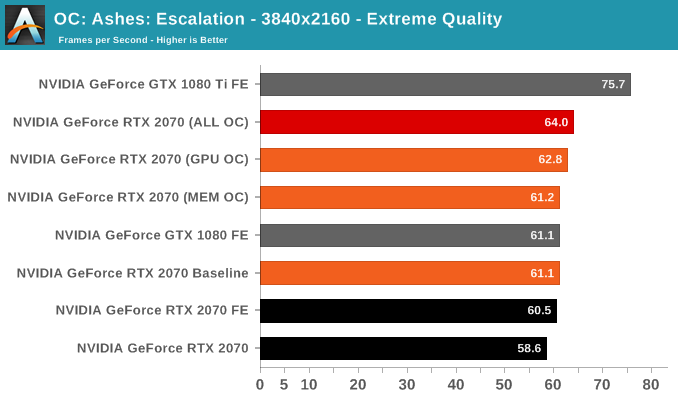
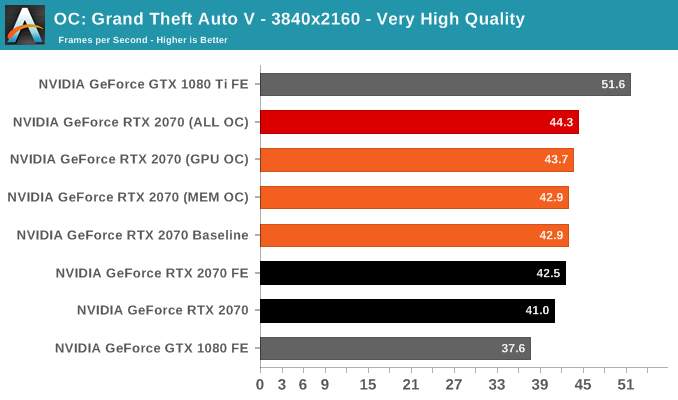

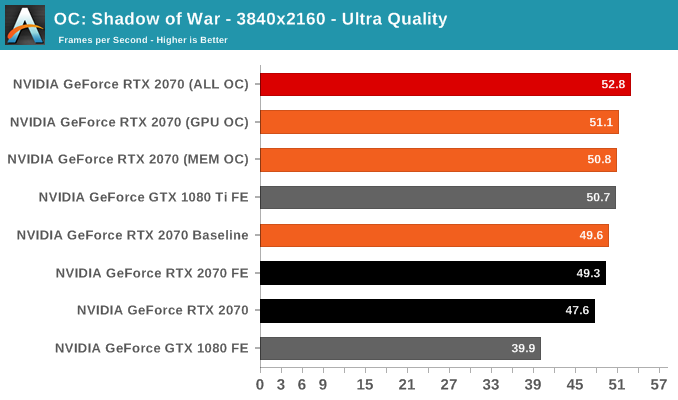
Although this is more of a cursory look than anything else, the combined overclock provides the best performance, just like it was for the Pascal based cards like the GTX 1080 and 1070. Given the GDDR6-equipped 2070, we would expect memory overclocking to be less effective, though it appears it's necessary for the best overclock here. Ultimately, the combined overclock can make up some ground, but the extent of its benefits are largely comparable to Pascal cards.
OC Power, Temperature, and Noise
There isn't much to add on the power, temperature, and noise front. The card will heats up a few more degrees, but kept relatively quiet thanks to its open air cooler. The full OC costs about ~30W at the wall in games, bringing it up to 1080 Ti FE levels, though only select games will see an overclocked RTX 2070 surpass the 1080 Ti.
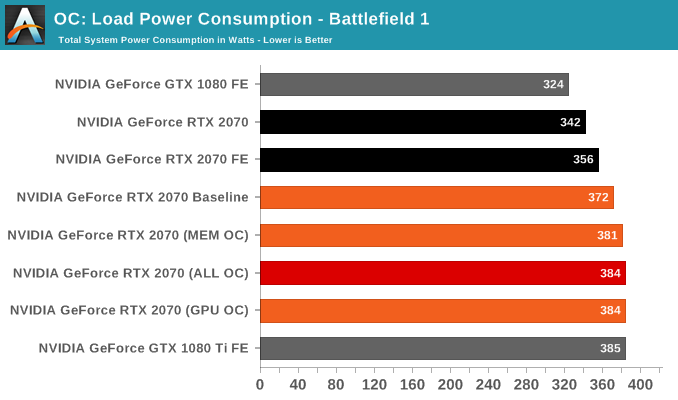
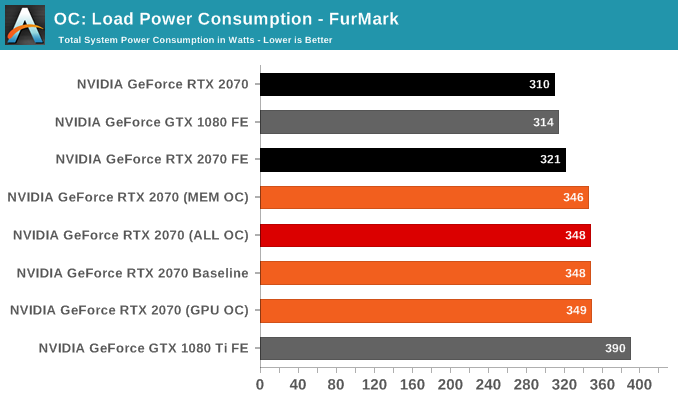
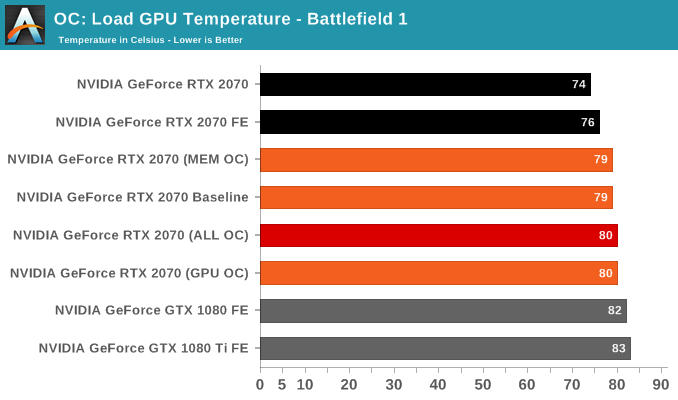
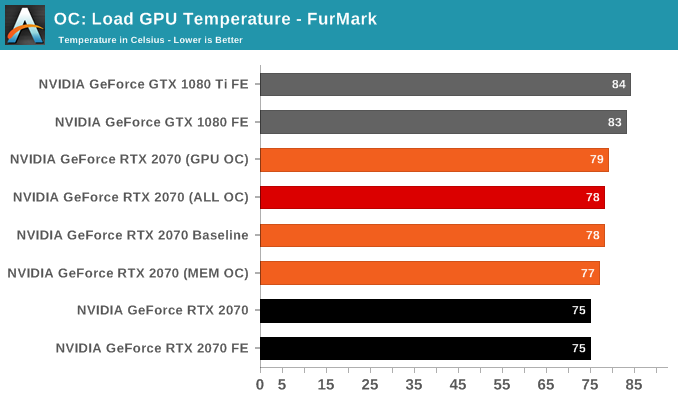

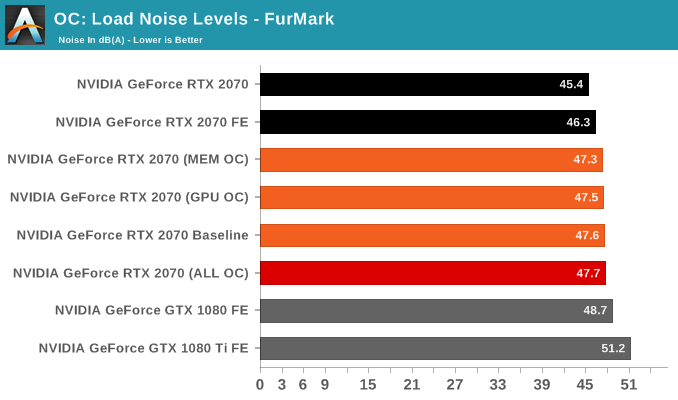










121 Comments
View All Comments
PeachNCream - Tuesday, October 16, 2018 - link
You've got a good graphics card in the 970 that should get you at least a couple more years of reasonable performance. If I were in your position, I wouldn't be in the market for a new GPU. However, I do sympathize with you when it comes to the cost it takes to be able to play these days and I agree that a shift to some form of console is a sensible alternative. PC hardware pricing has been on the rise in the last few years and it stings when you've come to expect performance improvements alongside cost reductions that we've been enjoying for the majority of the years since microcomputers found their way into homes in the 1980s.I think what's driving that is a diminishing market. Economies of scale don't work when there's no further growth for what's become a mature industry (PCs in general) and a declining segment (desktop PCs in specific) due to the slow shift of computing tasks to mobile phones. I don't see anywhere for desktop components to go but further up as we lean into the physical limits of the materials we have available while also contending with falling sales numbers. Compound that with the damage these prices will inflict on the appeal of PC gaming to the masses and we're starting to look at a heck of an ugly snowball on its way down the hill.
It's probably a good time to make a graceful exit like you're mulling over now. As someone else that's thrown in the towel, I can happily confirm there's lots of fun to be had on very modest, inexpensive hardware. From older games to low system requirements new releases, I have faith that there will always be a way to burn up a lot of free time at a keyboard even if you end up with very old, very cheap hardware.
WarlockOfOz - Wednesday, October 17, 2018 - link
Concur. I'm still rocking a 750Ti and feeling no need to upgrade it or the even older CPU (phenom x4) despite having money put aside. I'll replace when it breaks, like my fridge, unless something does make going past 1080p compelling - whether that's VR, ray tracing, or a must have game that I can't play at all.nikon133 - Tuesday, October 16, 2018 - link
I hear you.Been considering to make my current rig - older i7 (Haswel) with recently added 1070 - my last gaming PC. It really boils down to how next gen consoles turn out - but even as current gen is, I seem to be spending more time on PS4 than on gaming PC. In fact, MHW is the only game I am playing on PC atm, and event hat because of friends who insisted to play it on PC. Eventually, we are lucky if we get to play it together once a week, on average... definitely not worth investment into new rig, for me.
ingwe - Wednesday, October 17, 2018 - link
I mean you don't need the most top end or recent parts. I am gaming on a 5850 and i5-4670K (I think that is the model it has been so long I might be mixing things up). It runs great. 256 GB SSD and 16 GB of ram.The prices are crazy for the high end but you also don't need the highest end and most recent gen when performance improvements are marginal.
Farfolomew - Monday, October 22, 2018 - link
In the 486 days, computer gaming was worth that much money. The landscape was rapidly changing, games were rapidly changing. The internet was taking hold, 3D gfx starting to be born. It was amazing. It was money well spent to be able to play groundbreaking new types of games.Nowadays, although overall less expensive perhaps, your money doesn't buy you much new in terms of originality and exciting gameplay. All we get are prettier and prettier textures with duller and duller games. WoW and Counterstrike are STILL massively popular games, certainly not for their gfx.
Eris_Floralia - Tuesday, October 16, 2018 - link
Nate, iirc they handicapped the tensor performance of FP16 with FP32 accumulate, which is only half of those on equivlant Quadro cards, maybe that's why HGEMM performance is low.https://cdn.discordapp.com/attachments/47593159264...
Eris_Floralia - Tuesday, October 16, 2018 - link
*equivalentYojimbo - Tuesday, October 16, 2018 - link
The chart says half precision GEMM. So I think a lack of accelerated 32-bit accumulation should not be slowing the GPU down. As far as I know, the Turing Tensor Cores perform FP16 multiplications with FP16 accumulations at 8 operations per clock much like Volta Tensor Cores perform FP16 mults. with FP32 accumulation at 8 operations per clock.Eris_Floralia - Tuesday, October 16, 2018 - link
Turing FP16 with FP16 accumulate is fully enabled on all RTX cards, but FP16 with FP32 accumulate is 1/2 rate on GeForce cards.They used out of the box configuration which likely used Volta's FP16 with FP32 accumulate, resulting in half the performance.
HGEMM results for 2080TI/2080/2070 are very close to their 54/40/30 TFLOPS theoretical performance. If it was a Quadro card you will see double the performance with this config. If they updated the binary support, you'll likely see double the perf with FP16 accumulate too.
Yojimbo - Tuesday, October 16, 2018 - link
"They used out of the box configuration which likely used Volta's FP16 with FP32 accumulate, resulting in half the performance."It could be some driver error. But I don't see why the GPUs not having FP32 accumulate should be the ultimate cause for the poor results. I admit I don't know much about the test, but why should the test demand FP16 multiplications with FP32 accumulate? That's more or less an experimental situation only available commercially in NVIDIA's hardware, as far as I know. If the test is meant to use FP16 accumulate and FP32 is being forced in the test then the reason for the poor results is a driver or testing error, not that Turing GPUs only have FP16 accumulate at full Tensor Core speed for the precision.